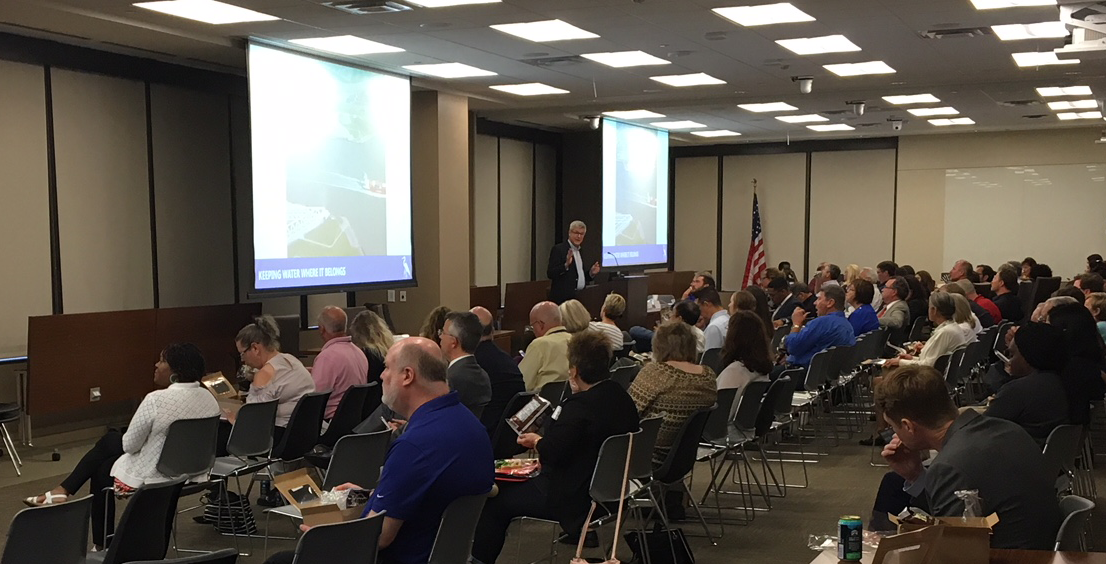Success Story: EDA Investments in Disaster Recovery and Resiliency Programs for Regions Impacted by Hurricane Harvey
Hurricane Harvey hit southeast Texas as a Category 4 storm on August 25, 2017. The National Oceanic and Atmospheric Administration (NOAA) has stated that Harvey was “the most significant tropical cyclone rainfall event” in U.S. history with up to 48-60 inches of rain over five days. 300,000 structures were flooded, the storm surge crested at over seven feet, and winds in excess of 130 mph caused significant damage. Current estimates place the total damage from Hurricane Harvey at $125 billion, making it one of the costliest natural disasters in U.S. history. The Presidential Disaster Declaration included 41 counties for individual assistance and 53 counties for public assistance.
For Hurricane Harvey, EDA’s Austin Regional Office (AURO) recognized that economic recovery activities should be led locally, awarding $640,000 Economic Development Assistance Program funding and $780,000 FY18 Disaster Supplemental Funding to the eight Harvey-impacted Economic Development Districts (EDDs): Deep East Texas Council of Governments, South East Texas Economic Development District, Gulf Coast Economic Development District, Brazos Valley Council of Governments, Capital Area Council of Governments, Coastal Bend Council of Governments, Alamo Area Council of Governments, and Golden Crescent Regional Planning Commission -- to support the development and implementation of Disaster Recovery and Resiliency Programs. The Texas Relief Fund provided $355,000 in local matches, and these funds were administered through a collaboration with the Texas Association of Regional Councils.
The Disaster Recovery and Resiliency Programs are being customized by each of the EDDs to meet the unique needs of communities located in coastal regions, agricultural settings, and urban areas. While the strategies may have some different elements, they share four common objectives:
- Identify potential resiliency, mitigation, and economic recovery projects;
- Coordinate with local, state, and federal agencies to develop and implement strategies that support resiliency and recovery;
- Bring together the public and private sectors to create a roadmap that supports planning, reconstruction, redevelopment, workforce, resiliency, and recovery; and
- Provide assistance to local governments, economic development organizations, and jurisdictional members on disaster response, mitigation, resiliency, and recovery to minimize the negative impact of future economic disruptions and increase the ability to regain pre-disaster economic productivity.
As part of its work in leading the Economic Recovery Support Function under the National Disaster Recovery Framework, EDA’s AURO partnered with each of the eight Harvey-impacted EDDs to host eight Long-Term Economic Recovery Workshops that brought together state and federal agency representatives to meet with elected officials, city managers, economic planners, and local stakeholders. Federal partners included the SBA, DOL, HUD, USDA, FEMA, DOI, EPA, DOI, Federal Reserve, and the DOT. Partners from the state of Texas included the General Land Office, Workforce Commission, Division of Emergency Management, Water Development Board, Commission on Environmental Quality, Railroad Commission, and the Department of Agriculture. Read a summary report of the workshops (PDF).
More than 300 local stakeholders attended the workshops, and state and federal agency representatives presented programs totaling more than $6.4 billion in available funding to support resiliency, mitigation, and recovery projects. Federal and state agency representatives learned about each other’s programs to improve coordination of resources and funding, and local stakeholders established relationships with state and federal representatives that could be helpful as the disaster recovery plans and activities are implemented.

Chuck Wemple, Executive Director at the Gulf Coast Economic Development District had this to say about EDA’s Long-Term Economic Recovery Workshops: “The workshop spotlighted the reason why EDA plays a key role in our region’s recovery from natural disasters — helping our communities get quick answers about specific projects that will help them become more resilient and restore their local economies. EDA leads the way on convening the entire spectrum of State and Federal funding partners. We had a fantastic turnout — from small towns and rural counties to major cities and our largest counties.”








